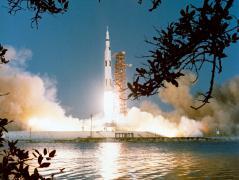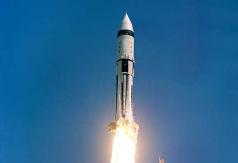
2 minute read
The journey to Apollo - Learning From Tragedy
- Michael Collins, CSM Pilot, Apollo 11
Advertisement
The development of Apollo was going well. The Command Module and Service Module, the main components of the Apollo spacecraft, had been proven in ground-based testing and had even flown to space on short uncrewed hops above the atmosphere, riding atop Saturn I rockets, the predecessor to the Saturn V rocket that would launch Apollo to the Moon. NASA considered the Apollo spacecraft ready for crewed flight, and so the Apollo 1 mission was drawn up, to place a crewed Apollo Command and Service Module into Low Earth Orbit (LEO). Apollo 1 mission patch
However, on January 27th, 1967, a flash fire in the Apollo 1 Command Module during a ground test caused a complete transformation in the approach to the Apollo program. A faulty electrical system in the Command Module, paired with the high oxygen environment, made even the aluminum burn. Three brave astronauts, Gus Grissom, Ed White, and Roger Chaffy, could not be saved once the fire had started, and shock swept through NASA. It could have been a tragedy that destroyed the Apollo program, but everyone at NASA was united in not allowing their friends and colleagues to have died in vain. Instead, hard lessons were learned, and extensive redesigns and a new reinforced determination to succeed powered the Apollo program forward to eventual success.
Following the fire, the Apollo Command Module was completely redesigned. The Block I version was scrapped in favor of the Block II, and the electrical systems were completely rebuilt. The old hatch had an overcomplicated latching system and opened inwards. After Apollo 1 capsule hatches were never designed like that again. The most important thing the investigation had found, however, was that a 100% pure oxygen environment can make even aluminum burn. NASA immediately changed the atmospheric composition and pressure inside the spacecraft, switching to a mix of Nitrogen and Oxygen.
The mission schedule was also redesigned. Apollos 2 and 3, seeing as they were dependent on Apollo 1, were removed from the flight plan, and instead, a much more cautious approach was taken.
Apollo 4 was the first uncrewed test of the Saturn V rocket, and Apollo 5 was the first uncrewed test of the Lunar Excursion Module (LEM), the spacecraft that would journey with the Command and Service Modules to the Moon, and make the journey to the Moon's surface and back. Apollo 4 went mostly smoothly, but there were some problems, that meant NASA would need to do another uncrewed test of the Saturn V before it would be rated for crewed flight.



